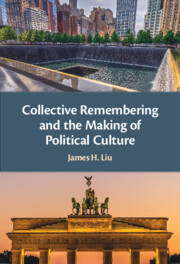Book contents
- Collective Remembering and the Making of Political Culture
- Collective Remembering and the Making of Political Culture
- Copyright page
- Contents
- Preface
- Part I Introduction to Collective Remembering
- Chapter 1 The Rise of Research on Collective Remembering
- Chapter 2 Top-Down Approaches to Collective Remembering
- Chapter 3 Bottom-Up Approaches to Collective Remembering
- Part II Developing a Theoretical Approach to Collective Remembering
- Part III Idiographic Case Studies of Collective Remembering
- References
- Index
Chapter 3 - Bottom-Up Approaches to Collective Remembering
from Part I - Introduction to Collective Remembering
Published online by Cambridge University Press: 04 August 2022
- Collective Remembering and the Making of Political Culture
- Collective Remembering and the Making of Political Culture
- Copyright page
- Contents
- Preface
- Part I Introduction to Collective Remembering
- Chapter 1 The Rise of Research on Collective Remembering
- Chapter 2 Top-Down Approaches to Collective Remembering
- Chapter 3 Bottom-Up Approaches to Collective Remembering
- Part II Developing a Theoretical Approach to Collective Remembering
- Part III Idiographic Case Studies of Collective Remembering
- References
- Index
Summary
There is consensus across many branches of the social sciences and humanities that history and the collective remembering of history is a central ingredient in the making of political culture. But what is the nature of the collective that is doing the remembering, and how does a collective remember? Disputation over such questions was responsible for sundering two great branches of social science a century ago. Following in the footsteps of Durkheim, sociologists tended to conceive of society as a functional, organic whole, consisting of interrelated parts tending toward a structural equilibrium (Pope, 1975). In such a conception of the collective, which can be described as “top down,” individuals are largely unimportant, compared to social forces (like norms, class structures, institutions, and the state). Psychologists, especially in the USA, where behaviorists dominated from the 1920s to the 1960s, rejected such a conception of the collective as the “Group Fallacy” (Allport, 1927). The Group Fallacy was how Allport referred to his Harvard colleague William McDougall’s notion of the Group Mind: He accused McDougall of attributing agency and structure to something that only existed in the imagination, and had no independent existence outside of the aggregation of individual tendencies. Such methodological individualism, though dampened by many critiques over the years (Ho, 1998), still characterizes much of psychology. Thus, from a bottom-up perspective, collective remembering is the parallel and distributed memory of individuals, functionally organized by their social and structural relationships (in families, in groups, institutions, and larger collectives like nations).
- Type
- Chapter
- Information
- Publisher: Cambridge University PressPrint publication year: 2022



